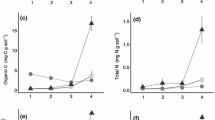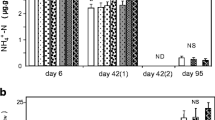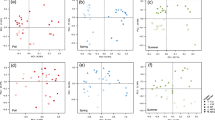Abstract
The mineralization of 2,4-dinitrophenol (DNP) and changes in the DNP-mineralizing population over a wide range of DNP concentrations were monitored to evaluate the dynamics of the DNP-mineralizing populations in two soils (soils 1 and 2). Curves of CO2 evolution were analyzed using nonlinear regression analysis and models incorporating parameters for population size and growth rate. The results of these analyses were compared to independent estimates of the DNP-mineralizing population from most-probable-number (MPN) determinations. The combined results of these analyses showed that 0.1μg of DNP g−1 of soil was too low a concentration to support maintenance or growth of the DNP-mineralizing population, whereas all higher concentrations supported either maintenance or growth of the population in soil 1. Independent estimates of population size showed good agreement between the nonlinear regression and MPN techniques, especially at initial DNP concentrations below 100μg g−1. Estimates of both population size and maximum specific growth rate varied with concentration, possibly indicating the existence of two different DNP-mineralizing populations in soil 1. In the other soil tested (soil 2), the population of DNP-mineralizers was much lower than in the first soil, and no evidence of two populations was obtained. In soil 2, good agreement between the nonlinear regression and MPN estimates of population size was also obtained. Results of this study demonstrate the power of using testable models of population dynamics to obtain useful estimates of parameters of microbial growth and survival in soil.
Similar content being viewed by others
References
Brunner W, Focht DD (1984) Deterministic three-half-order kinetic model for microbial degradation of added carbon substrates in soil. Appl Environ Microbiol 47:167–172
Dobbins DC, Pfaender FK (1988) Methodology for assessing respiration and cellular incorporation of radiolabeled substrates by soil microbial communities. Microb Ecol 15:257–273
Focht DD, Brunner W (1985) Kinetics of biphenyl and polychlorinated biphenyl metabolism in soil. Appl Environ Microbiol 50:1058–1063
Focht DD, Shelton D (1987) Growth kinetics ofPseudomonas alcaligenes C-0 relative to inoculation and 3-chlorobenzoate metabolism in soil. Appl Environ Microbiol 53:1846–1849
Nelson LM, Yaron B, Nye PH (1982) Biologically-induced hydrolysis of parathion in soil: kinetics and modelling. Soil Biol Biochem 14:223–227
Parker LW, Doxtader KG (1982) Kinetics of microbial decomposition of 2,4-D in soil: effects of herbicide concentration. J Environ Qual 11:679–684
Richards BN (1987) The microbiology of terrestrial ecosystems. John Wiley & Sons, New York
Rowe R, Waide J (1977) Microtechnique for most-probable-number analysis. Appl Environ Microbiol 33:675–680
Schmidt SK (1988) Degradation of juglone by soil bacteria. J Chem Ecol 14:1561–1571
Schmidt SK, Scow KM, Alexander M (1987) Kinetics of p-nitrophenol mineralization by aPseudomonas sp.: effects of second substrates. Appl Environ Microbiol 53:2617–2623
Schmidt SK, Simkins S, Alexander M (1985) Models for the kinetics of biodegradation of organic compounds not supporting growth. Appl Environ Microbiol 50:323–331
Scow KM, Schmidt SK, Alexander M (1989) Kinetics of biodegradation of mixtures of substrates in soil. Soil Biol Biochem 21:703–708
Scow KM, Simkins S, Alexander M (1986) Kinetics of mineralization of organic compounds at low concentrations in soil. Appl Environ Microbiol 51:1028–1035
Shea PJ, Weber JB, Overcash MR (1983) Biological activities of 2,4-dinitrophenol in plantsoil systems. Residue Rev 87:1–41
Simkins S, Alexander M (1984) Models for mineralization kinetics with the variables of substrate concentration and population density. Appl Environ Microbiol 47:1299–1306
Smith JL, McNeal BL, Cheng HH (1985) Estimation of soil microbial biomass: an analysis of the respiratory response of soils. Soil Biol Biochem 17:11–16
Soulas G, Chaussod R, Verguet A (1984) Chloroform fumigation technique as a means of determining the size of specialized soil microbial populations: applications to pesticide degrading microorganisms. Soil Biol Biochem 16:497–501
Van de Werf H, Verstraete W (1987) Estimation of active soil microbial biomass by mathematical analysis of respiration curves: calibration of the test procedure. Soil Biol Biochem 19:261–265
Author information
Authors and Affiliations
Rights and permissions
About this article
Cite this article
Schmidt, S.K., Gier, M.J. Dynamics of microbial populations in soil: Indigenous microorganisms degrading 2,4-dinitrophenol. Microb Ecol 18, 285–296 (1989). https://doi.org/10.1007/BF02075815
Issue Date:
DOI: https://doi.org/10.1007/BF02075815




